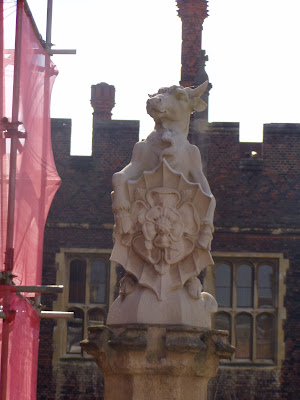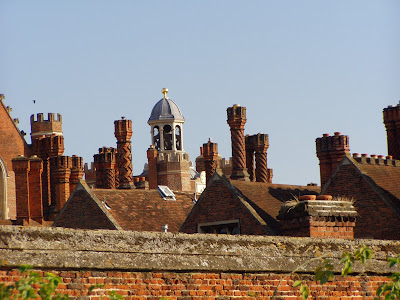10 October 2011
Hampton Court is one of those places you just have to include in a historical tour of London.
It was built by Cardinal Wolsey, right hand man to King Henry VIII before being gifted to the King in 1528 in an unsuccessful bid to halt his downfall. This occurred the following year though Wolsey did not live much longer, dying in 1530 as Henry VIII began expanding Hampton Court to make it a suitable residence for his court.
By the time Henry acquired Hampton Court, Wolsey had already undertaken extensive renovations. He wanted it to be a suitable show of his power and position, and also a place where he would be proud to entertain his King and foreign dignitaries. Wolsey added a new entrance courtyard, a long gallery overlooking new gardens and lined many of the rooms with fine tapestries acquired whilst on a diplomatic mission to France.
Finding one of the few warm sunny London days upon us, MP and I decided it to be a perfect day to visit the interiors and gardens of Hampton Court.Having already explored some of London with me, MP was well aware of my love of gargoyles and was perhaps a little worried that Hampton Court didn't disappoint.
Not only is it home to an amazing collection of 241 ornate brick chimneys, but also a number of grotesque animals and ugly faces preserved in stone along the rooftops and staring down from above window frames.
One of the catalysts for Wolsey's downfall had been his inability to get the Pope to grant to Henry the annulment he wanted for his marriage to Catherine of Aragon in order that he could marry Anne Boleyn. As a result, at the time of Henry's acquisition of Hampton Court, he was already preparing for Anne to take the position of his new wife.
Henry's contemporary love of Anne is represented in one of the ceiling roses of the palace: the Tudor Rose, symbol of King Henry VIII and his family overshadows the portcullis, possibly a symbol for London, and the Fleur de lys usually associated with France but also used by Henry to signify his nominal claim to the French throne. A third symbol is the intertwined initials H and A for Henry and Anne Boleyn.
Anne never had the opportunity to use the rooms Henry built for her as her fall from grace and execution occurred in 1536, three years after her secret marriage to the King. The following year, it was here that that Henry's third wife Jane Seymour gave birth to his longed-for heir who was baptised in the Chapel Royal. It was also here that 2 weeks after the birth, Price Edward VI's mother died from complications with the birth. Hampton Court was also the palace where Henry was informed of his fifth wife's infidelity. During the few days Catherine Howard was imprisoned at Hampton Court, legend has it she managed to escape her guards and ran screaming though the Haunted Gallery to beg the King for her life. Henry refused to see her and she was recaptured at one end beating her fists against the door to Henry's room.
Hampton Court Kitchens:
Upon acquiring Hampton Court, one of the first things Henry VIII did was enlarge the kitchens in order to cater for the 1000 odd people who made up his court. That the Palace is no longer a functioning royal residence means that the kitchens are not considered out of bounds to tourists.
Instead, with a little artistic license, they have been restored and peopled with Tudor-era cooks who happily discuss the ingredients, utensils and techniques used within the kitchen, whilst demonstrating to curious kids how some of the King's favourite biscuits were made and decorated.
Due to the extensive size of the kitchens, part of the room had been set aside for the archaeological teams who under the quizzical eye of tourists and amateur historians sorted through trays of finds that comprised of bones, seeds and crockery but looked more like rubble. It was from the tireless work of these archaeologists that the kitchen were able to be repopulated with the correct utensils and we have a better idea of the types of foods that were prepared within, even if it was peacock.
Access is also provided to the herb garden, which had been recreated in the style of a Tudor garden, and the cellars.
The Hampton Court Astronomical Clock set into the Anne Boleyn Gate. The Queen's new apartments within this gatehouse were still under construction when she was executed in 1536.
The Clock is an early example of a pre-Copernican Astronomical Clock and still displays the time of day, month, quarter of the year, phases of the moon, the date, the zodiac sign, and the high tide at London Bridge (essential for travel to and from London city).
We stumbled upon this statue in one of the main courtyards, and I was delighted with what would be the first of several visual reminders of King Henry VIII. It is of course highly unlikely that King Henry VIII would have ever sat on a bench in the main courtyard in such lowly clothes swigging from a jug, but one is allowed to daydream, and it does provide some delight for tourists like me.Saying that, with such a suspicious or grumpy look on his face, it might well be a depiction of the King.
Henry VIII's Great Hall:
This room was used as the staff canteen with up to 600 people eating here daily in two sittings. Court Masques were also held here as the room could be transformed by covering the walls with rich tapestries and using dozens of lit candelabras slung across the ceiling to pick out the gilt work of the wooden ceiling.
On two of the rafters, carved and painted heads, known as the Eavesdroppers, can be discerned... ...while the nearby horn room still contains the original oak steps leading down to the kitchens.
Wandering though the corridors of the court we were aware that it was still populated by a few members of the Tudor court however we were still surprised when suddenly ordered to stand aside for His Majesty.
He was perhaps not as good looking as his portrait would lead you to believe, but then the later is supposed to record his looks and power and might for prosperity so I shouldn't have been surprised.
After the death of Henry VIII in 1547, the court summered here under Edward VI, and it was here that Mary I honeymooned with her reluctant bridegroom Philip II of Spain. It was also the palace in which she was confined for what would turn out to be the first of her two phantom pregnancies. Having being confined here during Mary's false pregnancy, Elizabeth I had little love for the place, but none-the-less made some sensible alterations, installing a new privy kitchen and coach house.
Largely ignored by the early Jacobeans and the Commonwealth (the latter auctioned off most of the contents but left the buildings unscathed as Cromwell enjoyed staying here, acting the King), it wasn't until the reign of William III and Mary II that Hampton Court once again became home to the English court and underwent extensive renovations. Sir Christopher Wren drew up extensive plans paying homage to Versailles, however at a time when all monarchs throughout Europe could not build palaces without referencing Versailles, these were deemed to be too subtle an homage. What resulted instead were the facade of the South front overlooking the Privy Garden, and the Fountain Court, where the repetitive style then synonymous with Versailles was enlivened by the use of pink brickwork and contrastingly pale Portland stone.
While these new renovations created new state rooms and private apartments for the King and Queen, they replaced half the original Tudor palace, resulting in the loss of Henry VIII's state rooms and private apartments.
 |
| William and Marys' intertwined initials are displayed here on the door lock. |
The King's (William III) Staircase, leading up to his State Rooms:
| The Great Staircase, Hampton Court by Richard Cattermole |
The King's Private Dining Room, hung after Queen Mary's death with portraits by Kneller of ladies of Mary's Court. This selection of paintings is known as the Hampton Court Beauties.
Gallery of Statues:

Cartoon Gallery:
This was used by William III to display a set of cartoons by Raphael bought by Charles I. These are 17th Century copies while the originals rest in the Victoria and Albert Museum, on loan from the Queen.
| 'The Cartoon Gallery at Hampton Court in England' from Pyne's Royal Residences (1819) |
Queen Caroline's bathroom:
Surprisingly, Hampton Court still has residents, with some of the grace-and-favour apartments still being occupied. These apartments were awarded by the monarch in recognition of great service to king(/queen) and country. It was in one of these apartments that the 1986 fire started.
Aside from the official history, there is also the more subtle presence of centuries of visitors, tourists, some of whom have taken the liberty of vandalising their surroundings by carving their name, a date, into the foundations of the building.
Hampton Court Gardens:
Having caught more than a few glimpses of the gardens from the upstairs windows we headed out doors to enjoy them in person.
 |
| The Pond Garden |
 |
| The Privy Garden from William III's apartments |
 |
| The Privy Garden from William III's apartments |
 |
| The Great Fountain Garden |
 |
| The Pond Garden with the Banqueting House in the background. |
 |
| MP hiding in the hedge. |
 |
| The Lower Orangery Garden |
 |
| Wren's Southern Façade built for William III and Mary II (with some tourists |
















































No comments:
Post a Comment